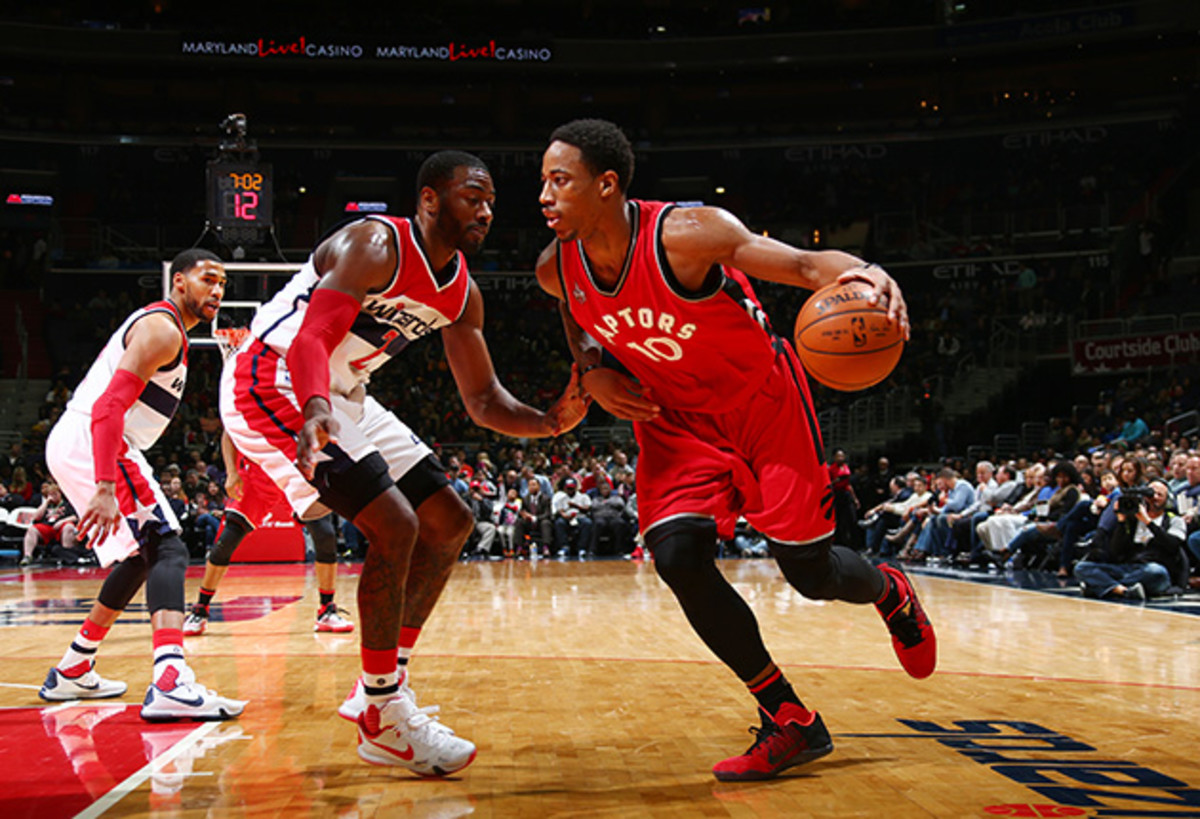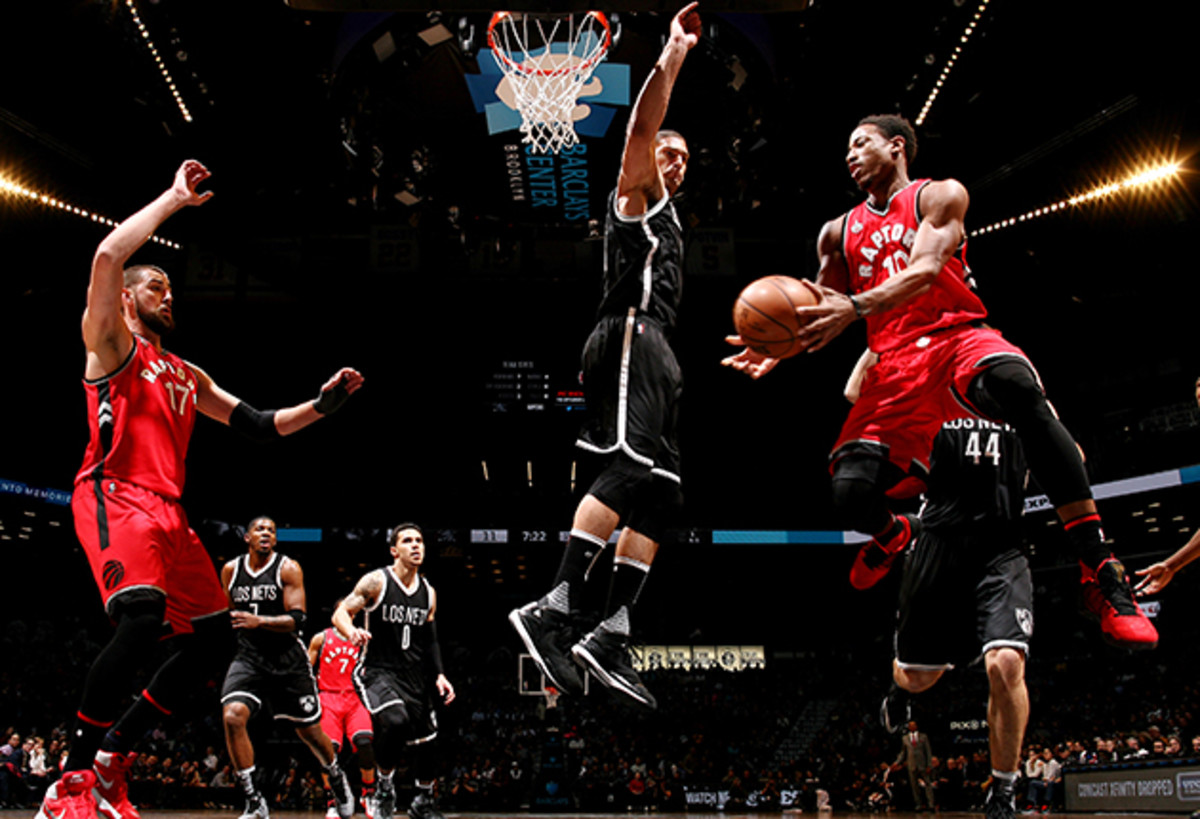Inside job: DeMar DeRozan’s interior approach paying off big for Raptors

NEW YORK — DeMar DeRozan leans against the wall of an elevator in midtown Manhattan and morphs into a mathematician. The Raptors guard considers a hypothetical scenario in which he decides to take eight three-pointers in a game—which has happened only once in his six-year career—and lists all the opportunities he would negate as a result.
“I could have an off night and go one of eight,” DeRozan says. “I think that could have been eight drives. I could’ve scored four times and got fouled twice. I think any time I drive I’m going to score or get fouled.”
In this moment, DeRozan utilizes simple math to explain the complex equation that has defined his career. He maintains the reputation of a driver who does so in lieu of three-pointers, a rare perimeter player in the modern NBA.
At no point has DeRozan played to his strengths quite like this season. He leads the NBA in points scored on drives with 8.9 per game, connecting on 52.4% of attempts. Both numbers rate ahead of hard-charging superstars like LeBron James and Russell Westbrook.
NBA Power Rankings: Carmelo keys Knicks' resurgence at the right time
The byproduct of DeRozan’s added aggression is what Raptors coach Dwane Casey called the best stretch of basketball of his career. On the season, he maintains a stat line of 22.9 points, 4.4 rebounds and 4.1 assists, but also boasts the highest PER of his career (21.1) and best true shooting percentage since his rookie season (54.9%).
This success should speak for itself, but in a time when the three-point shot is more popular than ever, DeRozan’s methods don’t always stand out. DeRozan, who attempts 1.8 three-pointers each night, takes 15.4 shots inside the arc per game and has put up a whopping 601 on the season, which is more than any other player in the league, including paint-dwellers like Andre Drummond and Brook Lopez.
In the past, when DeRozan’s shot selection was less refined, this approach might have had an adverse effect. That’s far from the case this season, though. What DeRozan might lack in three-point looks has been replaced with efficient inside play.

, he’s barreled deeper into the lane, finding 43.9% of his shots within 10 feet of the basket.
DeRozan is quick to state that he does not shun three-pointers. He said he is confident in his outside shot and expects to hit when he does launch from deep. That said, he also prefers to work the defense for a closer look rather than shoot a three. When pressed on the topic, DeRozan agreed with the old adage that rushed three-point looks bail out defenses.
The Fundamentals: Kawhi Leonard, NBA’s most understated superpower
“That’s my mindset,” DeRozan said. “I know I could shoot threes whenever I want at will, or come down and shoot six, seven, eight, nine threes. But, for me, I feel like that’s a bailout. I feel like I’m settling or taking the easy way out instead of knowing I can get to the basket.”
Many coaches preach that it is best to make defenses work with the pass, yet DeRozan chooses to do so off the dribble. He has produced 49.5% of his scores after three dribbles or more, per NBA.com, and tends to isolate often as a result.
[youtube: https://youtu.be/W4siPBe764k]
The uptick in dribbles works in conjunction with the progression of DeRozan’s off-season ballhandling drills. DeRozan buckled down over the past three summers with trainer, Johnny Stephene, to become more of a threat off the bounce.
Stephene, who started the popular HandleLife brand, has attracted a long list of NBA clients with his personalized workouts. The Dallas Mavericks enlisted Stephene’s help during training camp this fall, and he put players like Kevin Durant, Victor Oladipo and Seth Curry through the paces in recent years. Stephene watched Synergy Sports Technology's video breakdowns and formatted a special system to suit DeRozan's preferences before they worked out together. The idea was to arm DeRozan with functional dribbling skills.
“If I know DeMar likes to catch it on the right wing or when he comes down on the fast break he always goes on the left,” Stephene said, “I’m going to give him a couple moves to make him feel comfortable and we’re going to work on it repeatedly until it becomes second nature. And that’s what happens with DeMar when he trains, everything becomes second nature to him.”
Under Stephene’s watchful eye, DeRozan has leveraged his improved handle to score more unassisted points and post a career high in assists. In fact, only 30.8% of his points are assisted this season. On the other hand, his assist rate has increased from 17% to 21%
“A lot of times I don’t even look to score when I get in the paint, because I know I draw so much attention," DeRozan said. "I try to draw three or four guys to me and get my teammates going, get them open shots, get them open threes.”
DeRozan’s increased awareness caught the eye of Casey, who has watched his star player became a more adept screen-and-roll operator and playmaker. Casey was particularly fond of DeRozan’s improved chemistry with backcourt mate Kyle Lowry.
Unlike DeRozan, Lowry doesn't hesitate to launch a three. Case in point: DeRozan has converted 20 total three-pointers this season, while Lowry, who earlier this year attempted 17 threes in one game against the Hornets, has knocked down 102.
“Really he and Kyle have a chemistry together that’s uncanny,” Casey said. “The continuity they’ve had over the last few years, they know each other, they know where each other’s going to be, they know each other’s game. On the offensive end, that’s huge because with the continuity they understand what the plays are, what they’re looking for, and where each other will be, so it’s like second nature for those two to work together.”

At a sturdy 6’7”, 220 pounds, DeRozan can see the floor and carve out lanes through which he can drive and kick out. Spotting players like Lowry, Terrence Ross or Patrick Patterson is made easier by the fact that DeRozan’s eyes are constantly on the second level of the defense, anticipating the next rotation.
“I read the four guys,” DeRozan said. “I never pay attention to the defender guarding me. I always look at the four guys behind them, what they’re doing, how they react if I go to the right or if I go to the left or even in screen and roll, it’s basically reading the other four guys behind my defender.”
What can't he do? Draymond Green's skills put him in a category of his own
One of DeRozan’s more consistent targets, DeMarre Carroll, was recently lost to arthroscopic knee surgery. While he was an important shooter, Carroll mainly functioned as the Raptors’ chief defensive stopper, a role DeRozan must now assume.
In talking with Casey, DeRozan’s potential on defense piqued the Raptors head coach's interest more than any other topic. On the day Carroll underwent knee surgery, Casey had already heaped new defensive assignments on his star shooting guard. He pointed to improvement on defense as the next progression in DeRozan’s career.
“In stretches last year he would come to me and say, ‘Coach, let me guard so and so,’” Casey said. “And when a player does that, that’s when you give him the opportunity because now he’s taken responsibility. He can do it. Having DeMarre kind of took that pressure off of him, but now it’s back on him to take those guys those bigs, I call them the power threes of today, he’s got to take those guys now.”
The final step before DeRozan is heralded like his All-Star peers is to strike the same fear in opponents from deep as he does inside. But DeRozan, who has felt snubbed since high school, still isn’t quite sure this theory adds up.
“Even though at the end of the day I know I can shoot threes,” DeRozan said, “I feel comfortable in the style I like playing, and until I’m proven otherwise when I’m out there on the court, I’m going to stick to it.”
